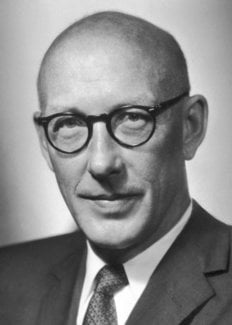Edward Tatum
Biographical

Edward Lawrie Tatum was born on December 14th, 1909, at Boulder, Colorado, U.S.A. He was the eldest son of Arthur Lawrie Tatum, Professor of Pharmacology at the University of Wisconsin Medical School, and Mabel Webb Tatum. After the death of his mother, his father married the former Celia Harriman.
Tatum was educated at the University of Chicago and Wisconsin, taking his A.B. degree in Chemistry in 1931, his M.S. degree in Microbiology in 1932 and his Ph.D. degree in Biochemistry in 1934. For the Ph.D. degree his thesis was on work on the nutrition and metabolism of bacteria which he had done under the direction of Edwin Broun Fred and William Harold Peterson. This work no doubt laid the foundations of his later work with George Wells Beadle, which was to earn for their book, in 1958, the Nobel Prize in Physiology or Medicine.
After taking his doctor’s degree, Tatum studied for a year at the University of Wisconsin and then was awarded a General Education Fellowship at the University of Utrecht, Holland. He then joined the Department of Biological Sciences at Stanford University, California, where he was Research Associate from 1937 until 1941, and Assistant Professor from 1941 until 1945. From 1945 until 1948 he was successively Assistant Professor of Botany and Professor of Microbiology at Yale University. In 1948 he returned to Stanford University as Professor of Biology and later became Professor of Biochemistry there. It was during this period of his life and work at Stanford University that he collaborated with George Wells Beadle, who was Professor of Biology (Genetics) at that University until 1946.
Tatum’s research has been concerned primarily with the biochemistry, nutrition and genetics of microorganisms and of the fruit fly, Drosophila melanogaster. During his fruitful collaboration with George Wells Beadle he took charge of the chemical aspects of their joint work on the genetics of eye-colour in Drosophila and, when he and Beadle decided to give up their work on Drosophila and to work instead with the fungus Neurospora crassa, it was Tatum who discovered that biotin was necessary for the successful cultivation of this fungus on simple inorganic media and thus provided these two workers with the genetic material that they needed for the work which gained them, together with Joshua Lederberg, the Nobel Prize.
In 1953, he received the Remsen Award of the American Chemical Society. He is a member of the Advisory Committee of the National Foundation and has served on research advisory panels of the American Committee of the National Research Council on Growth. He also served for 10 years on the Editorial Board of the Journal of Biological Chemistry. He is now a member of the Editorial Board of Science and of Biochimica et Biophysica Acta.
Tatum is married to Viola Kantor. He has two daughters, Margaret and Barbara, born to him and his first wife, June Alton.
This autobiography/biography was written at the time of the award and first published in the book series Les Prix Nobel. It was later edited and republished in Nobel Lectures. To cite this document, always state the source as shown above.
Edward Tatum died on November 5, 1975.
Nobel Prizes and laureates
Six prizes were awarded for achievements that have conferred the greatest benefit to humankind. The 12 laureates' work and discoveries range from proteins' structures and machine learning to fighting for a world free of nuclear weapons.
See them all presented here.
